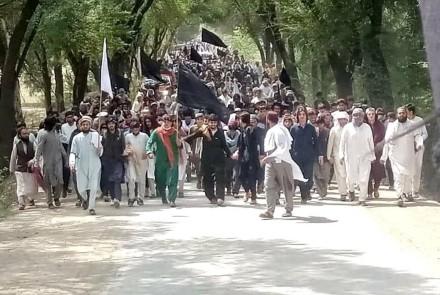During the last few years, Waziristan--both the southern and northern districts with this name--have been in the news for their residents’ powerful agitation against the government’s security policies (mostly on social media and international media, as Pakistan’s military has banned any mention of the area in the “mainstream media”).
The area came into prominence in early 2018 when it emerged as the center of a bold indigenous political uprising against the “three Ds policy” (Death, Destruction and Dislocation) of the federal government toward the seven districts of what was known as the Federally Administered Tribal Area (FATA), and six subdivisions in the adjoining districts known as the Frontier Regions (FRs).
The said area, which holds about 10 million Pashtuns, is ruled under draconian colonial laws dating to the British period and has mostly been used as a launching pad for war in Afghanistan for the last four decades. But the area known as FATA saw the most brutal repression of its entire history between 2002 and 2014 when it was ruled by the syndicate of terrorists who launched a new war against the US-led international forces and the forces of the Islamic Republic of Afghanistan.
For Pakistani generals, the Taliban’s war in Afghanistan was important to achieve their old objective of “strategic depth.” Ten million Pashtuns living in FATA were thrown to the wolves as terrorists killed thousands of tribal elders with impunity. And that wasn’t all: military operations launched by the Pakistan army to convince the international community that the nation was serious about the war on terror would also inflict death and destruction on the local population.
About three million people had to leave their homes and hearths and become Internally Displaced Persons (IDPs) in other districts and even other provinces where they faced humiliation, discrimination and racial profiling.
Thus the worst victims of terrorism were portrayed as its perpetrators. The main towns of what was then FATA were destroyed in the devastating armed conflict that went unabated in the area. Large bazaars and houses were looted by each warring side. Most of the political parties, threatened by the wrath of the Pakistani military, did not raise their voices for the oppressed Pashtuns of that area.
From this political vacuum a youth-led popular uprising calling itself the “Pashtun Tahafuz (Security) Movement (PTM)” emerged to challenge the brutal and oppressive policies of the Pakistani military. Today, they draw massive crowds who protest the use of their area for war in Afghanistan.
However, the security institutions, instead of changing their policies, labeled the new movement “anti-state” and claimed it was working for hostile intelligence agencies.
The security establishment did go through the motions of “reforming” the area by merging it with Pakhtunkhwa province, but without fully opening it to civil society or transferring its governance to civil administration, as legally required by the Constitution.
Why? Because what is at stake is the future of the “Taliban project,” which the Pakistani security state has pursued consistently and with great determination.
The Taliban’s “invincibility” has largely been made possible by the vast sanctuaries the group has enjoyed in Pakistan since its inception in 1994.
Ideologically trained (brainwashed) in any of the 36,000 religious seminaries established in Pakistan during—or after—the 1980’s war in Afghanistan (also called the Afghan Jihad), the Taliban could depend on base camps on the eastern side of the Durand Line even after their worst defeats inside Afghanistan.
Even after 9/11, the Pakistani security state allowed the Taliban to not only enter Pakistan after their Emirate was overthrown by the US in Afghanistan, but to regroup in 2003 (along with other components of an international terror syndicate) and restart a new war in Afghanistan from their bases in Pakistan. The US did put pressure on Pakistan to act against the core of Al Qaeda, which threatened US security, but the US has always regarded the Taliban as a local/regional problem.
Recently, new momentum has been witnessed in protests against Taliban sanctuaries in the former FATA in general and in Waziristan in particular. The large-scale regrouping of the Taliban for their “plan B” in Afghanistan is a major concern. The local population, in light of their horrific experiences of the last two decades, is worried about a new cycle of violence threatening their area.
Targeted killings of locals by terrorists are on the rise, and people are also getting killed in the punitive actions of the Pakistan army.
Large public meetings held by the PTM in Miran Shah, Wana, Bannu, Peshawar and other places have demanded the dismantling of Taliban sanctuaries that bring bloodshed to their homes. Manzoor Pashteen, the main leader of the PTM, and his comrades including Ali Wazir, Mohsin Dawar, Abdullah Nangial, among others, have been leading the huge gatherings.
It is not just the PTM giving voice to the demand of the local population against the militant sanctuaries. Recently, large tribal conglomerates have come out with clear demands for ending the aforementioned sanctuaries. In February, the Utmanzai Jirga, an umbrella organization representing all tribes of north Waziristan, passed a clearly-worded resolution against what they called the “good Taliban” (a term coined by Pakistani intelligence agencies for the Taliban who go to fight in Afghanistan and who aren’t involved in fighting on the Pakistani side of the Durand Line).
Last week, on two occasions, in Jani Khel and in Miran Shah, thousands of people carrying the dead bodies of locals killed by the so-called good Taliban tried to march on Islamabad to press their demand to dismantle the Taliban sanctuaries. On both occasions the government tried to pacify the protesters by promising to clear their areas and to stop providing sanctuary.
Also last week, a grand Jirga of Ahmadzai Wazir, another large tribal conglomerate, categorically demanded that sanctuaries for the “good Taliban” be done away with, as they are spreading death and destruction in their area.
Ali Wazir and Mohsin Dawar, the two young elected parliamentarians from Waziristan, as independent members of the National Assembly, have repeatedly raised the issue on the floor of the House.
Ali Wazir has been incarcerated at the Karachi Jail for the past several months for an allegedly seditious speech, but his supporters believe that the main reason for his being detained is his categorical stand against Taliban sanctuaries.
It is worth mentioning that seventeen members of his immediate and extended family, including his father, brothers and cousins, have been murdered by the Taliban.


